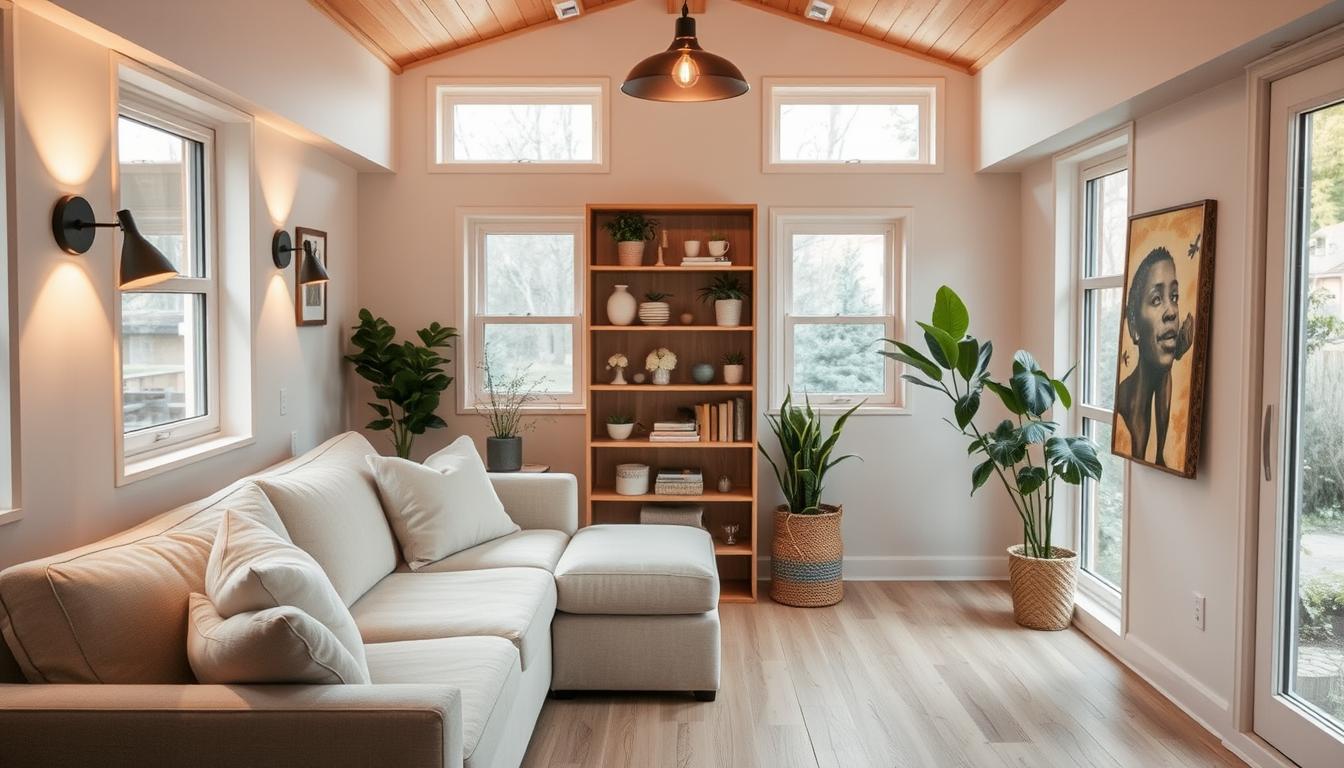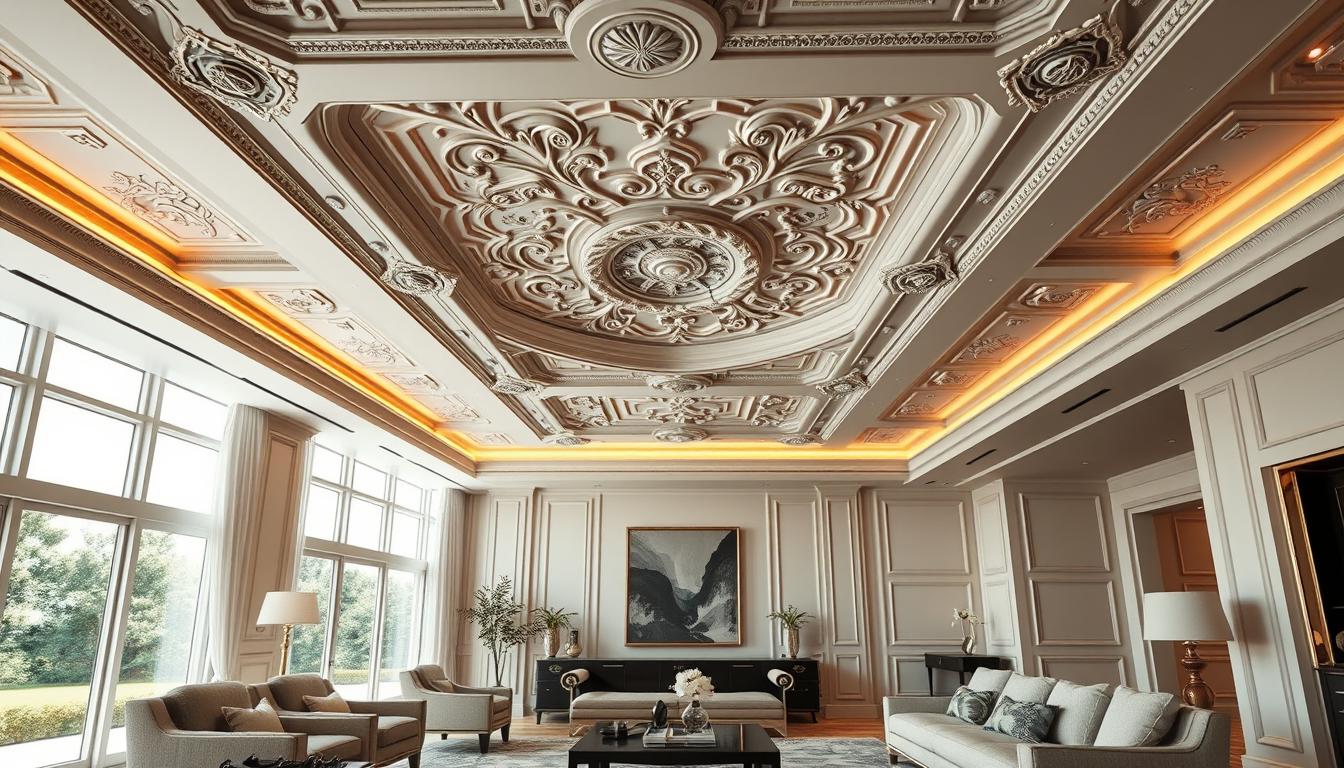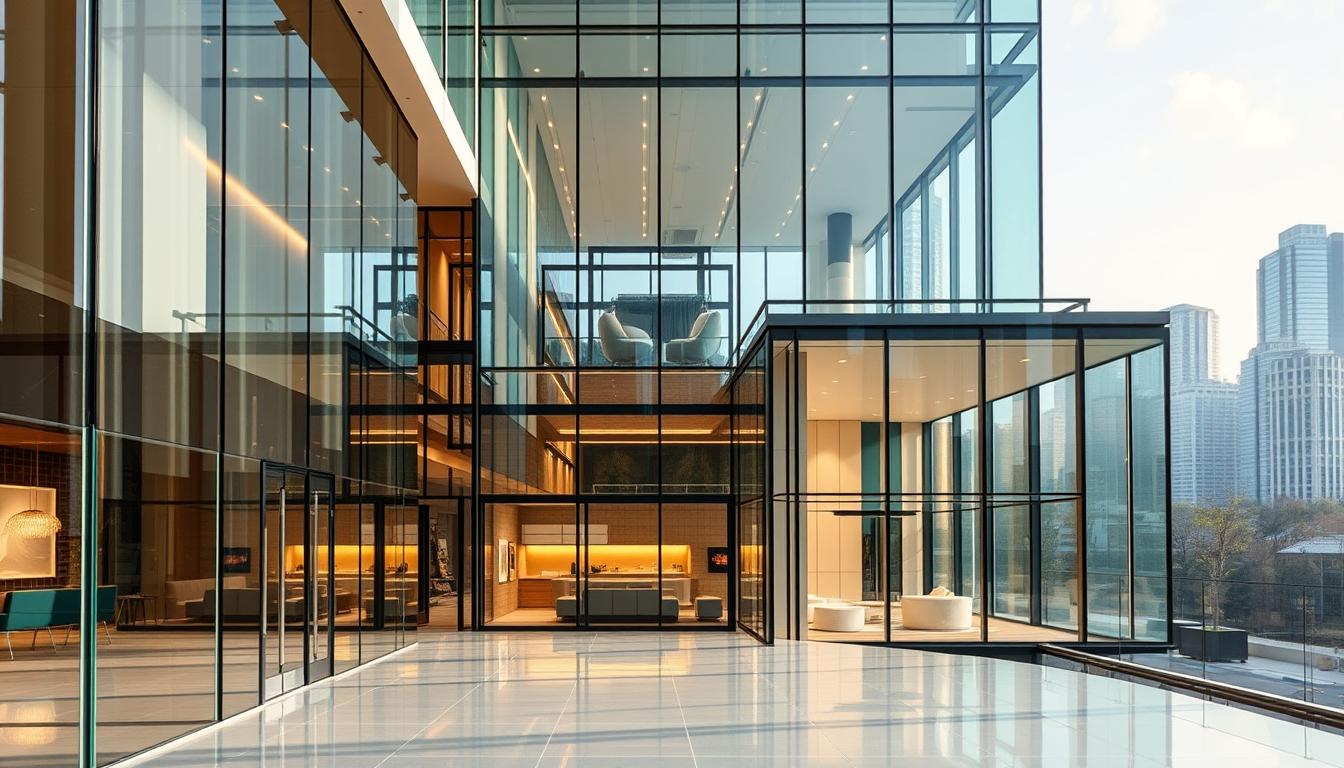Did you know the average tiny home is about 400 square feet? That’s roughly the size of a small studio apartment. This small space needs careful planning to be both functional and comfortable.
At our organization, we’ve found that good small space design is key. By using storage well and smart design, we can turn tiny spaces into cozy homes.
Living in a small space can be tough, but with the right interior design tips, it can also be very rewarding. We aim to give you useful advice on making the most of your space.
Key Takeaways
- Maximizing storage is crucial in tiny home living.
- Clever design strategies can make a big difference in small spaces.
- Utilizing vertical space can help keep your floor clear.
- Multifunctional furniture is a must-have for compact living.
- Creating a cozy atmosphere is achievable with the right design.
Embracing Minimalism in Tiny Home Design
Minimalist living turns tiny homes into calm and open spaces. It’s about keeping things simple and clutter-free. This way, tiny home dwellers enjoy a more peaceful place to live.
Understanding Minimalism
Minimalism focuses on simplicity and cutting out the unnecessary. In tiny homes, it means choosing each item carefully. It’s about living with only what adds value to your life, making your home clutter-free and efficient.
Benefits of Decluttering
Decluttering is key to minimalism. It keeps your home tidy, lowers stress, and boosts focus. Decluttering helps you keep only what’s truly needed or brings joy. It’s a way to live more mindfully and appreciate what you have.
Choosing Essential Items
Picking the right items for your tiny home is crucial. Choose items that do more than one thing or make you happy. For example, multipurpose furniture saves space and keeps things functional. This makes your home feel bigger and less cluttered.
In short, minimalism in tiny home design is more than looks. It’s a lifestyle that brings efficiency, clarity, and peace. By understanding minimalism, decluttering often, and picking essential items, you can make your tiny home feel spacious, organized, and truly yours.
Maximizing Vertical Space for Storage
Vertical space is key in tiny homes, offering many chances for creative storage solutions. By using the vertical space, we can boost our tiny home’s storage without losing living area.
Creative Shelving Solutions
Installing creative shelving is a simple way to use vertical space. Floating shelves add storage and a modern look. They’re great for books, decorations, or kitchen items, keeping the floor clear.
Stackable or modular shelving units are also smart. They fit different spaces and can change as needed. They’re ideal for storing various items, like linens or cleaning supplies.
Utilizing Wall Space
Using wall space is vital in tiny homes. Wall-mounted cabinets, hooks, or racks offer more storage and keep the floor open. This makes the space feel bigger.
For instance, wall hooks can hold bikes, bags, or kitchen tools. Wall cabinets store dishes, cleaning stuff, or linens, keeping them handy but out of sight.
Overhead Storage Ideas
Overhead storage is another smart use of vertical space. Overhead racks or cabinets are perfect for less-used items, like seasonal decorations or winter clothes.
Using space above doors for storage is also smart. Over-the-door racks are great for jackets, bags, or cleaning supplies. They keep things organized and out of the way.
By using these ideas, we can optimize our tiny home’s vertical space. This makes our living area more organized, clutter-free, and spacious.
Choosing the Right Color Palette for Interiors
Choosing the right color palette is key to a harmonious tiny home interior. The right colors can greatly affect how your tiny home feels. It can be more spacious or cozy.
Light Colors to Enhance Space
Light colors make a tiny home feel open and spacious. Shades like white, cream, and pale gray reflect light well. Light colors on walls and ceilings can make a space feel bigger.
- Soft whites and creams reflect natural light well.
- Pale grays and blues add calmness while keeping the space open.
- Get expert advice on color selection from professional interior services.
Accent Walls for Character
Light colors make a space feel larger, but accent walls add character. A bold or contrasting color on one wall creates a focal point. This adds visual interest and distracts from the tiny size.
- Choose a wall that naturally draws attention, like behind a fireplace or art.
- Pick a color that complements the palette but stands out as a statement.
- Think about the psychological effects of colors; red energizes, blue calms.
Textures and Patterns
Textures and patterns add depth and interest to a tiny home. Mixing them creates a cozy atmosphere. It’s important to balance them to avoid overwhelming the space.
- Pair smooth surfaces like glass or metal with rougher textures like wood or fabric.
- Use patterns on accent pieces like throw pillows, rugs, or curtains for interest.
- Make sure the textures and patterns fit with your tiny home’s color palette and style.
By choosing a color palette with light colors, accent walls, and textures and patterns, you can create a cozy and spacious tiny home interior. These compact living ideas help you maximize your small space. They turn it into a cozy tiny house interior you’ll love.
Smart Furniture Choices for Small Areas
Sustainable tiny home design is more than just materials. It’s also about the furniture that fills the space. Choosing smart furniture is key to creating an eco-friendly and functional home.
Multipurpose Furniture Options
Multipurpose furniture is essential in tiny homes. It does more than one thing, saving space and reducing clutter. For example, a storage ottoman can be a seat and a storage spot. A murphy bed folds up against the wall, freeing up floor space.
Examples of multipurpose furniture include:
- Sofa beds that convert into guest beds
- Dining tables with built-in storage
- Desks that fold against the wall
Foldable and Expandable Designs
Foldable and expandable furniture are great for tiny homes. They can be rearranged or compacted to fit different needs. This makes the space more versatile and clutter-free.
Benefits of Foldable and Expandable Furniture:
- They provide flexibility in how the space is used.
- They help keep the space clutter-free.
- They are perfect for small areas where space is limited.
As “The Tiny House Movement is not just about downsizing; it’s about living more intentionally.” This quote shows the importance of choosing the right furniture for tiny homes. It’s about making choices that improve our living experience and protect the environment.
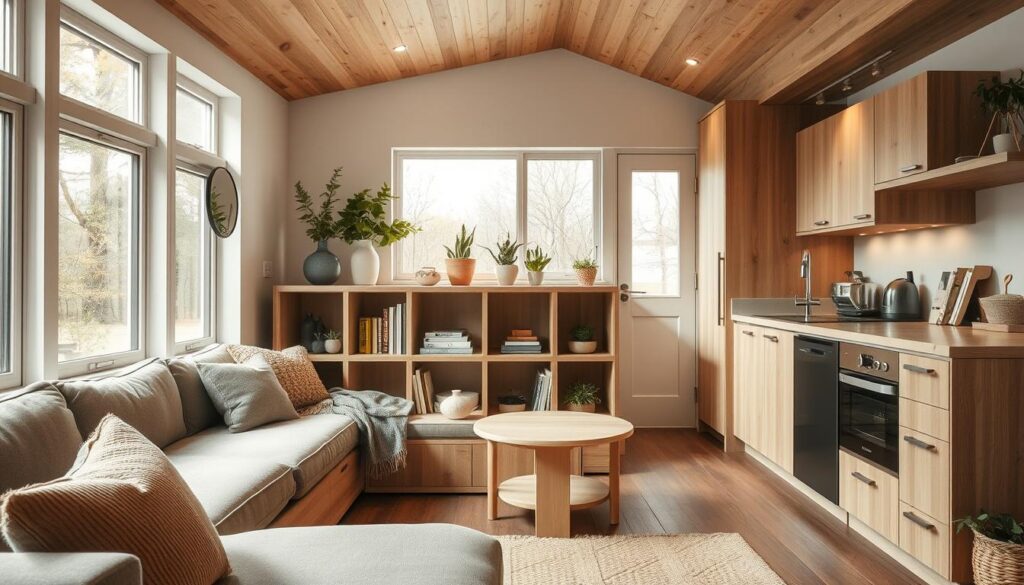
By using multipurpose, foldable, and expandable furniture, we can make tiny homes sustainable and functional. This approach supports the goals of sustainable tiny home design. It focuses on efficiency, minimalism, and caring for the environment.
Creating Flow with Open Layouts
Open layouts make tiny homes feel more open and free. They remove walls to let spaces flow together. This makes the home feel bigger and more inviting.
Defining Zones without Walls
Open layouts can be tricky to zone without walls. We use area rugs, different lights, and smart furniture to mark areas.
- Use area rugs to define living and dining areas.
- Implement different lighting for various zones.
- Place furniture in a way that creates natural pathways.
Open Shelving for Airiness
Open shelving keeps tiny homes feeling airy. It stops the clutter that closed cabinets bring. It also helps us keep things tidy and simple.
Maintaining a Cohesive Look
To keep an open layout looking good, pick a color scheme and furniture style. This creates a smooth flow from room to room.
| Design Element | Tips for Cohesiveness |
|---|---|
| Color Palette | Choose 2-3 main colors and stick to them. |
| Furniture Style | Select a consistent style or era for furniture. |
| Decor | Use similar textures and materials for decor items. |
With these tips, we can make our tiny home feel big, airy, and useful.
Using Lighting Effectively in Tiny Homes
In tiny homes, lighting does more than just light up the space. It makes the home feel warm and inviting. We can use several strategies to make our tiny home both functional and beautiful.
Layered Lighting Techniques
Layered lighting uses different light sources to make a space look good and work well. It combines ambient lighting for overall light, task lighting for specific areas, and accent lighting for highlights. This mix creates a balanced and appealing space.
- Use floor lamps or ceiling fixtures for ambient lighting.
- Employ table lamps or under-cabinet lighting for task lighting.
- Apply spotlights or string lights for accent lighting.
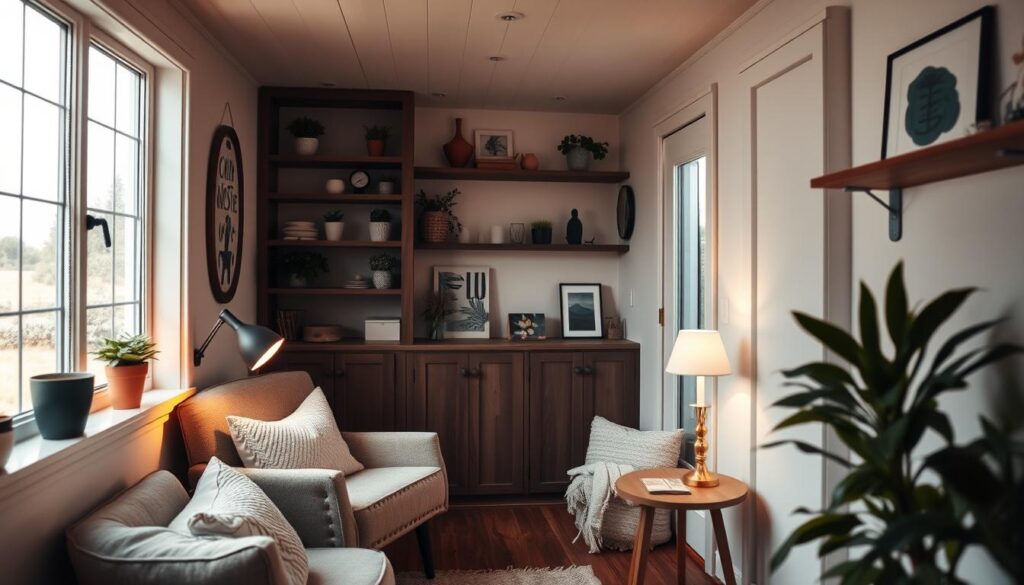
Natural Light Enhancement
Using natural light is key in tiny homes. It makes the space feel bigger and more welcoming. We can boost natural light with sheer curtains, skylights, or bigger windows. Sheer curtains let sunlight in while keeping things private. Skylights bring light from above, lighting up areas windows can’t reach.
- Install larger windows or sliding glass doors.
- Use mirrors opposite windows to reflect natural light.
- Keep windows unobstructed by furniture or heavy drapes.
Selecting the Right Fixtures
Picking the right lighting fixtures is important for both looks and efficiency. We should choose fixtures that save energy and match our home’s style. LED lights are a smart choice because they use less energy and last longer. Plus, simple designs can add to our home’s beauty without taking up too much space.
By using these lighting tips, we can make our tiny home feel big, welcoming, and stylish. Good lighting design is essential for an efficient tiny home decor that’s both useful and lovely.
Personalizing Our Tiny Home Interior
Making our tiny home feel like our own is key. We can do this by adding things that show who we are. This way, even a small space can become a cozy and welcoming home.
Displaying Personal Collections
One great way to make our tiny home special is by showing off our favorite things. This could be vintage items, artwork, or keepsakes. For example, we can display antique books on a wall-mounted shelf. It’s not just decoration; it’s a way to start interesting conversations.
Marie Kondo once said, “The purpose of a thing is not just to use it, but to spark joy.” By choosing items that make us happy, we can make our space truly personal.
Incorporating Family Heirlooms
Adding family treasures to our tiny home is another way to make it special. Things like antique furniture, vintage jewelry, or family photos can add warmth and history. For instance, an old family quilt can be hung on the wall or used as a cozy throw blanket.
By using these meaningful items, we connect with our heritage. When designing our tiny home, we can look at Tumbleweed Houses for ideas on how to include these personal touches.
Unique Art and Decor Ideas
Adding unique art and decor is another way to personalize our tiny home. This could mean getting custom artwork, making our own decor, or finding special pieces from local artists. For example, a handmade macrame wall hanging or a custom piece of pottery can add a personal touch.
Remember, personalizing our tiny home is about making it our own. By combining our collections, family treasures, and unique decor, we can create a home that is both beautiful and meaningful.
“The home should be the treasure chest of living.” –
Outdoor Connections: Expanding Living Space
The idea of living space in tiny homes goes beyond just walls. It includes the outdoors. By adding outdoor areas to our tiny homes, we can make our living space bigger. This makes our tiny home more sustainable and connects us more with nature.
Functional Outdoor Decks
Building functional decks is key to expanding our outdoor living space. A good deck can be a dining area or a place to relax. It’s important to choose materials that are both sustainable and strong.
Key considerations for deck design include:
- Using sustainable materials that are resistant to weathering
- Incorporating storage solutions to maintain a clutter-free environment
- Designing the deck to seamlessly integrate with the indoor living space
Inviting Outdoor Areas
Creating welcoming outdoor areas is more than just making them look good. It’s about making spaces where we can relax and spend time with others. Adding comfy seating, good lighting, and decorations can turn our outdoor spaces into places we love.
“The garden is a love song, a duet between a human being and Mother Nature.” – Allen Lacy
To make our outdoor areas truly welcoming, we should think about a few things:
- Comfortable and weather-resistant furniture
- Layered lighting to create ambiance
- Decorative elements that reflect our personal taste
By focusing on these, we can make outdoor spaces that are not just bigger. They also make our lives more sustainable and enjoyable.
Sustainable and Eco-Friendly Interior Practices
Sustainable living is key in tiny home design. Our interior choices help reduce our ecological footprint.
Creating an eco-friendly tiny home interior focuses on materials and appliances. Making smart choices in these areas greatly reduces our tiny home’s environmental impact.
Choosing Sustainable Materials
Choosing sustainable materials is vital for our tiny homes’ environmental footprint. Some top eco-friendly materials include:
- Reclaimed Wood: It reduces waste and adds charm to our tiny home interiors.
- Bamboo: Bamboo is renewable and great for flooring, furniture, and decor.
- Low-VOC Paints: These paints cut down on indoor air pollution, making our homes healthier.
- Recycled Materials: Using recycled glass or metal for countertops and decor is eco-friendly and unique.
Energy-Efficient Appliances
Energy-efficient appliances are crucial in sustainable tiny home design. They cut down on energy use and lower bills. Some examples are:
- LED Lighting: LEDs use less energy and last longer than traditional lights.
- Energy Star Rated Appliances: Appliances with the Energy Star label meet high energy efficiency standards.
- Induction Cooktops: They are more energy-efficient than electric or gas stoves.
By using sustainable materials and energy-efficient appliances, we can make our tiny home interiors beautiful, functional, and eco-friendly.
Planning for the Future: Adapting Our Tiny Spaces
When designing our tiny homes, we must think about the future. Our needs might change, so it’s key to make our spaces flexible and adaptable. This way, our homes will stay useful and cozy.
Adapting to Change
Being flexible in design is crucial for small spaces. It lets us change our living areas as needed. We can use modular furniture and decor that does more than one thing.
Storage for the Unforeseen
Good storage is essential for a tidy tiny home. Hidden spots and furniture that does double duty help keep things organized. This makes our space both neat and efficient.
Seasonal Living Considerations
It’s important to prepare for the seasons in our tiny home design. Adding things that can be changed or stored, like seasonal decor, keeps our home comfy all year.
